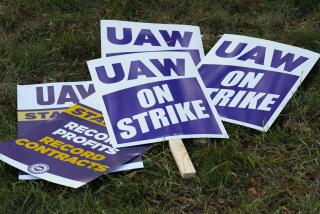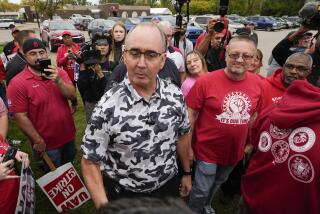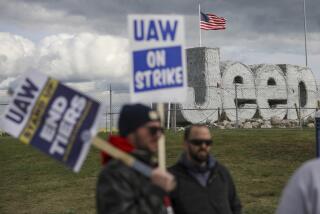Van Nuys Plant Won’t Build New Sports Car
- Share via
General Motors’ Van Nuys assembly plant, which builds the Chevrolet Camaro and its sister model, the Pontiac Firebird, will not build the next generation of those sports cars if they are approved for production, a GM spokesman said Friday.
In addition, GM has asked the Van Nuys plant to develop a plan for converting the facility to a “flexible” plant once it loses the Camaro/Firebird project, he said. Such a plant would be capable of producing more than one model and would focus on building vehicles that are popular in the western United States, said GM spokesman Darwin E. Allen in Warren, Mich.
“One of the big advantages of Van Nuys is its location to a large market,” Allen said. “It can capitalize on that advantage by giving itself the flexibility to respond to that market” by quickly changing models to meet shifting sales demand, he said.
Allen said GM planners are recommending that the new versions of the Camaro and Firebird be built at GM’s plant in Ste. Therese, in Quebec, Canada, if the auto maker decides to introduce the new models, which likely would be in the early to mid-1990s. The new version of these cars is still in the early stages of development and it is still uncertain if--or when--it will actually go into production.
Allen said that in the meantime the Van Nuys plant is scheduled to keep building the current generation of Camaro and Firebird, known inside GM as the F-cars.
He declined to say why GM had chosen Ste. Therese over Van Nuys, which employs about 3,500 hourly workers, to build the new F-cars. But the Van Nuys location is seen as a disadvantage in building the Camaro and Firebird, whose sales have been steadily falling over the past decade.
Many of the plant’s components have to be shipped from Midwest suppliers, and more than half of the cars are then sold east of the Rockies. The shipping costs each way add several hundred dollars to the price of each car.
GM’s announcement, which was made to the plant’s workers Thursday, was one of several plant changes disclosed by the auto maker. Among other steps, GM plans to shift production of full-size vans from Lordstown, Ohio, and Scarborough, in Ontario, Canada, to Flint, Mich., in 1991 or 1992. The moves could idle 2,500 workers in Lordstown and 2,700 workers in Scarborough.
The decision to eventually move F-car production out of Van Nuys lifted some of the uncertainty that has surrounded the facility for the past two years. Besides the Ste. Therese facility, GM plants in Oklahoma City and Pontiac, Mich., also were vying to build the next F-cars, creating doubt about whether the Van Nuys plant would survive if the cars’ production was moved elsewhere.
For that reason, officials of the United Auto Workers union, whose Local 645 represents the Van Nuys hourly workers, have spent the last several months asking GM to consider making the facility a flex plant. Union executives likely will work with the plant’s management in developing a proposal, said Henry C. Gonzalez, assistant Western region director of the UAW.
GM’s decision to study the idea is “the first step toward that job security” the Van Nuys workers seek, he said. “I think there will be an announcement down the road that there’s life in Van Nuys.”







